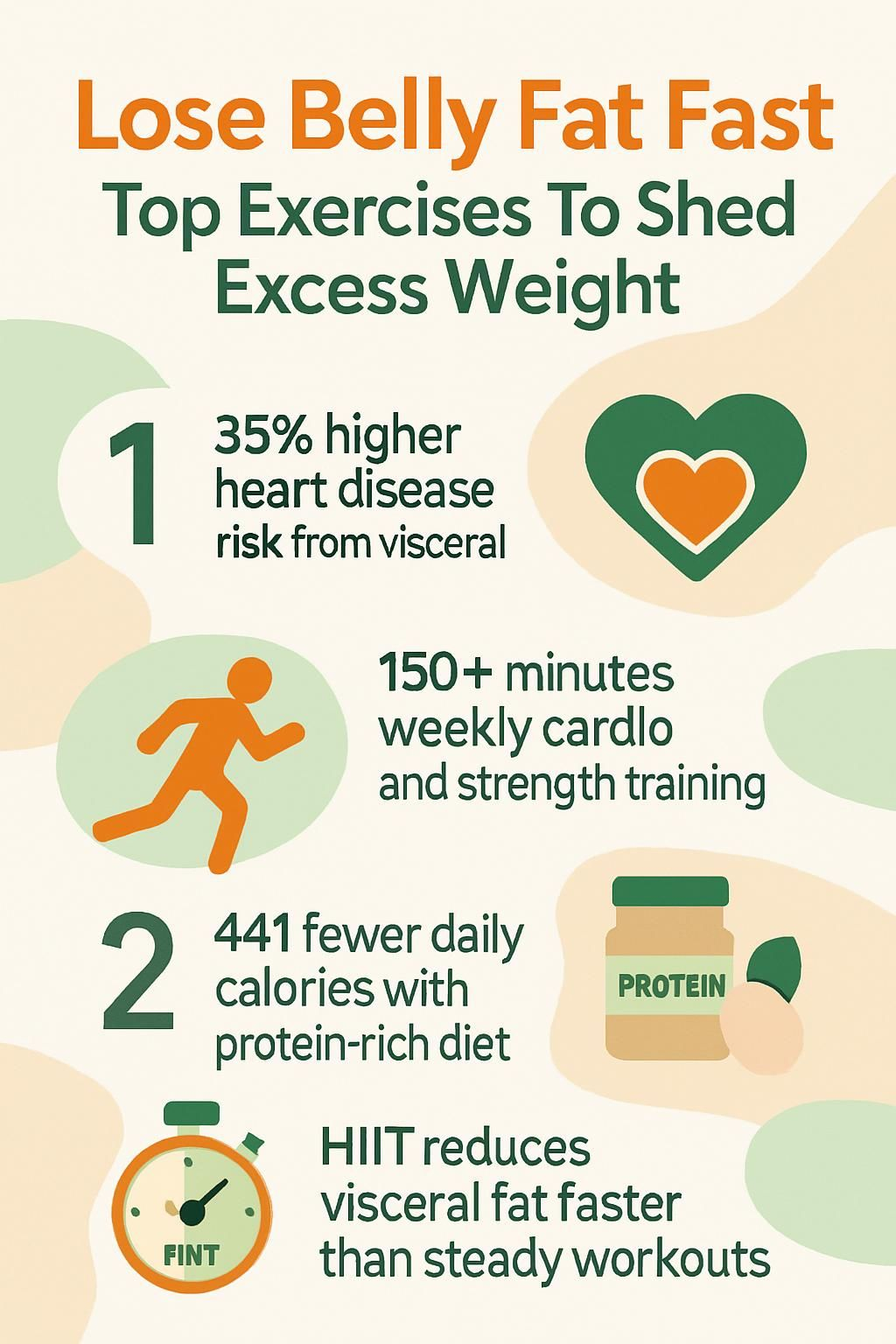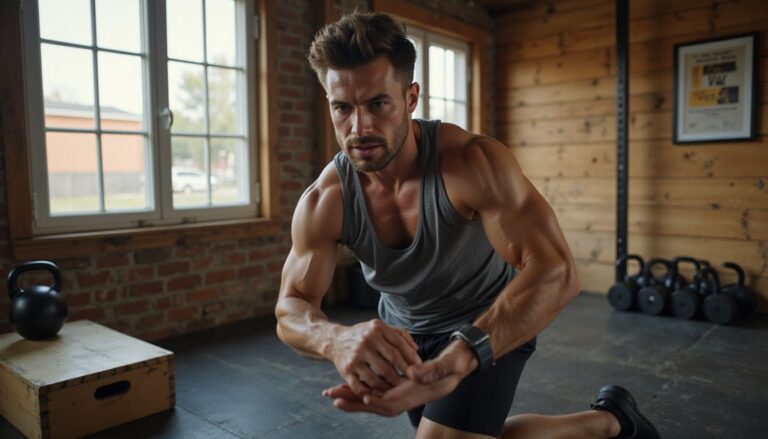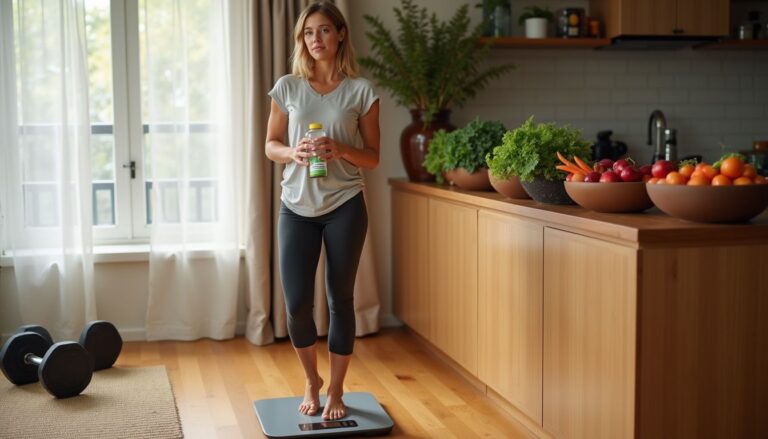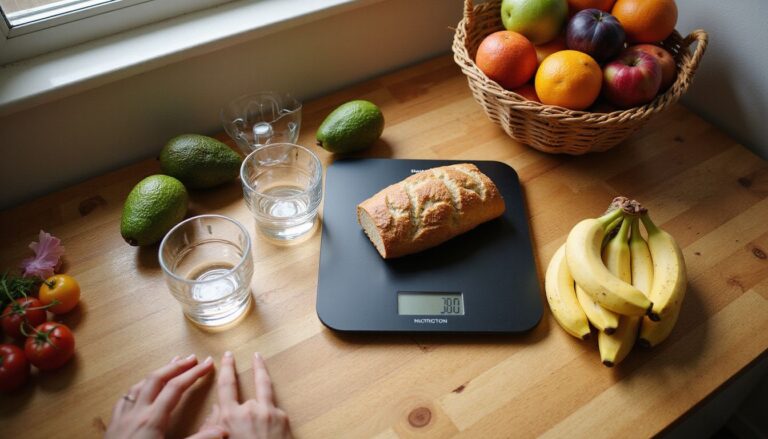Lose Belly Fat Fast: Top Exercises To Shed Excess Weight
Our Nutrition Assistant AI Suite will transform your body. You will lose fat, get toned, and build muscle. Gain confidence and optimal health.
Belly fat can affect how you feel, how you move, and your health. Extra fat around your midsection raises the risk of heart disease, type 2 diabetes, and other conditions. Research shows that fat stored deep in the abdomen, called visceral fat, is the most harmful.
This guide highlights the best exercises to lose excess weight and explains smart lifestyle changes that help reduce stubborn belly fat faster. Use these steps to trim your waistline and support long-term health.
Key Takeaways
- Visceral belly fat raises the risk of heart disease by up to 35% and type 2 diabetes by up to 60%, based on Mayo Clinic and CDC reports.
- Aim for at least 150 minutes of weekly aerobic exercise plus strength training for the best reduction in waist size.
- HIIT, short intense intervals followed by brief rests, burns more calories after workouts and trims visceral fat faster in several studies.
- A protein-rich plan, about 20 to 30% of daily calories, helps protect muscle during weight loss and may reduce daily intake by up to 441 calories1.
- Managing stress and getting at least seven hours of sleep support healthy cortisol levels and make it less likely that you gain belly fat.

Understanding Belly Fat and Its Risks

Belly fat is not just extra weight. It signals higher risk for heart disease and type 2 diabetes. Knowing the types of fat helps you make better choices.
What Are the Differences Between Subcutaneous and Visceral Fat?
Subcutaneous fat sits just under your skin. You can pinch it on your belly, hips, or arms. Visceral fat lies deeper in your abdomen and surrounds organs like the liver, intestines, and pancreas.
Health risk rises as visceral fat grows. For women, a waistline greater than 35 inches, about 89 centimeters, suggests higher risk. Doctors often flag this as a warning sign to act now.
I once measured above my hip bone and saw nearly 36 inches. That single number pushed me to start brisk walking and light strength training the same week.
Visceral fat is not a harmless reserve, it is a serious health risk.
How Does Excess Belly Fat Affect Your Health?
Too much visceral fat links to heart disease, insulin resistance, type 2 diabetes, high blood pressure, stroke, sleep apnea, fatty liver disease, and some cancers. It also raises the risk of early death compared with a healthy weight.
Even moderate weight loss can shrink your waistline and improve energy. Many people notice better blood sugar control and cholesterol after losing belly fat.
Below is a brief summary of risk changes tied to high visceral fat.
| Health Condition | Increased Risk |
|---|---|
| Heart Disease | Up to 35% |
| Type 2 Diabetes | Up to 60% |
| Some Cancers | Varies |
| High Blood Pressure | Significantly higher |
Small, steady changes matter. As my waist dropped, climbing stairs felt easier, and I slept better.
How Does Exercise Help Reduce Belly Fat?
Exercise raises your metabolism and helps you burn calories. Over time, that lowers total body fat, including fat around your belly.
Can Physical Activity Target Belly Fat Specifically?
Spot reduction, losing fat from only one area, is a myth. Ab moves strengthen muscles, but they do not burn belly fat in isolation. To reduce visceral fat, you need a mix of aerobic exercise, strength training, and a healthy eating plan.
HIIT and resistance training often reduce visceral fat more effectively than subcutaneous fat. They boost your calorie burn during the workout and for hours after it ends.
Adults benefit from at least 150 minutes of moderate to vigorous activity each week. In one Johns Hopkins project, combining a balanced diet with regular exercise improved artery function as weight came down.
When I trained with intervals and core work for six weeks, my waist dropped by two inches. The changes showed across my body, not only at my midsection.
Spot reduction lacks scientific support.Mayo Clinic Patient Education
Build muscle with resistance training and use cardio like jogging or cycling. That combination encourages overall fat loss, which includes the belly.
Why Are Consistent Workouts Important for Fat Loss?
Consistency drives results. Regular workouts burn more calories each week and reduce visceral fat around your organs. Many adults do best with 30 to 60 minutes of moderate to vigorous activity on most days.
Strength work also maintains skeletal muscle. More muscle raises your resting metabolism, so you burn more calories even while sitting or sleeping.
People who keep moving are less likely to regain lost weight. Exercise improves blood vessel function and lowers inflammation, which supports long-term changes in body composition.
Best Cardio Workouts for Belly Fat Reduction
Cardio helps you lose weight and improve fitness. These workouts raise your heart rate and create the calorie gap needed to reduce body fat.
How Does Running or Jogging Burn Belly Fat?
Running or jogging helps you meet the 150 minutes per week guideline for aerobic exercise. These activities raise your heart rate, increase calorie burn, and help your body tap stored fat for fuel.
Research shows running may lower insulin levels, which supports the breakdown of visceral fat near your organs. With steady training, many people see a smaller waist in a few weeks.
Last year I ran three days a week for 30 minutes. My tracker showed more calories burned each session, and my midsection started to lean out.
Can Cycling Help You Lose Belly Fat?
Cycling is an effective, low-impact cardio choice. It elevates your heart rate, burns calories, and uses fatty acids for energy. That combination makes it ideal for trimming belly fat without stressing your joints.
The CDC recommends at least 150 minutes of moderate-intensity aerobic activity each week. Pair regular cycling with smart nutrition to reach goals faster.
Is Swimming Effective for Weight Loss?
Swimming trains the entire body. It meets guidelines for vigorous aerobic exercise, supports joint health, and burns meaningful calories. According to the Dietary Guidelines for Americans, a person around 160 pounds can burn about 423 calories in one hour of moderate swimming.
If impact bothers your knees or back, the pool offers a friendly path to improved fitness and fat loss.
How Does Skipping Rope Aid in Fat Loss?
Jump rope workouts are fast and intense, so they burn many calories in a short time. They help you meet or exceed the suggested 75 minutes of vigorous activity for adults each week.
Intervals with a rope can reduce waist size more than many steady, easy workouts. Ten focused minutes can rival a quick run. I added a ten-minute rope session before dinner and, within six weeks, needed a tighter belt notch.
Strength Training to Combat Belly Fat
Strength training builds lean muscle, raises daily calorie burn, and helps reduce stored fat. It also shapes your frame and keeps weight off long term.
What Are the Benefits of Strength Training for Fat Loss?
More muscle means a higher resting metabolic rate. Your body uses extra energy even while you rest, which makes a calorie deficit easier to maintain. Strength training also prevents the muscle loss that often occurs during dieting.
When I added squats and push-ups three days a week, my arms felt firmer and my waist looked flatter in about six weeks.
How Can Lifting Weights Help Reduce Belly Fat?
Lifting weights increases muscle mass, which helps you burn more calories all day. Studies show that combining resistance training with aerobic exercise leads to greater fat loss and better muscle retention.
Two or more days per week of strength work is a smart target. With regular training, your body becomes more efficient at using food for energy instead of storing it as fat.
What Are Essential Bodyweight Exercises for Fat Loss?
Bodyweight moves are convenient and effective. You can do them at home, at a park, or while traveling.
- Squats recruit large leg muscles, raise your heart rate, and help burn calories. Aim for several sets of 10 to 20 reps.
- Push-ups train your chest, arms, and core at once. Do them on your toes or knees based on your strength.
- Lunges target glutes, quads, and hamstrings while engaging stabilizers. This supports a higher metabolism and less fat storage.
- Planks build your entire core. Hold for at least 30 seconds, rest, then repeat.
- Mountain climbers combine cardio and core work. They raise your heart rate quickly and support fat loss.
- Jump squats add a power element to squats and increase calorie burn in short sessions.
- Burpees blend strength and cardio. Each rep trains multiple muscles and raises calorie burn per minute.
Combine these exercises with aerobic activity for the best results. Many people see steady reductions in visceral fat when they move daily and stay consistent.
Benefits of High-Intensity Interval Training (HIIT)
HIIT uses short bursts of hard effort followed by brief rests. It can burn more calories in less time and lower cortisol, the stress hormone that promotes belly fat storage.
What Are the Key Benefits of HIIT for Fat Loss?
HIIT boosts calorie burn during your session and for hours after you finish. That afterburn helps reduce visceral fat faster than many steady, moderate workouts.
It also improves both aerobic and anaerobic fitness. Many busy people prefer HIIT because 20 to 30 minutes can deliver strong results without long gym visits.
Which HIIT Routines Are Most Effective for Belly Fat?
Choose simple intervals that push your heart rate high, then allow short recovery. These options work well and fit most schedules.
- Sprint intervals: Run hard for 30 seconds, then walk for 60 seconds. Repeat 8 to 10 times.
- Cycling sprints: Pedal all out for 20 to 30 seconds, then spin easy for 60 seconds. Repeat several rounds.
- Bodyweight circuits: Rotate burpees, jump squats, and mountain climbers with brief rests. Focus on form and speed.
- Jump rope intervals: Fast jumps for 40 seconds, then 20 seconds easy. Fifteen minutes can rival other cardio sessions.
- Rowing efforts: Row hard for 45 seconds, then rest for one minute. Complete 7 to 9 cycles.
- Short HIIT sessions, 20 to 30 minutes a few times a week, have shown meaningful waist reductions in recent peer-reviewed research.
- I paired mountain climbers with core twists twice weekly. After six weeks my waist dropped two inches and my abs felt stronger.
- Use multi-joint moves that engage many muscles. This approach increases calorie burn and supports better nutrition use from high-fiber, protein-rich meals.
Pick one routine and repeat it for several weeks. You will build skill and see clearer progress.
Core Strengthening for Better Abs
Core exercises stabilize your spine and support your organs. A strong core improves posture and makes every workout safer and more effective.
How Do Abdominal Crunches Strengthen Your Core?
Crunches focus on the rectus abdominis, the front abdominal muscle that flexes your spine. With practice you improve stability and endurance.
- Crunches target the rectus abdominis directly, helping you control spinal flexion.
- Regular sets build strength and stamina for daily tasks and sports.
- Stronger core muscles reduce strain on the back and support spinal health.
- Studies suggest that proper form lowers injury risk during activity.
- Consistent practice improves core endurance and balance.
- Start with two sets of 15 to 20 reps. Slow the movement or add a light weight across the chest to make it harder.
- Mix crunches with other core moves to balance muscle development and avoid overuse.
- After three weeks of steady work, I noticed better posture at my desk and less fatigue.
- Many women find scheduled core work helpful after menopause when belly fat often increases.
- Strong abdominal muscles stabilize the area around your organs during movement.
What Are Elevated Leg Raises and How Do They Help?
Elevated leg raises target the lower abs. Perform them on a mat or hanging from a bar for more difficulty. Lifting with control engages your core and hip flexors, which improves strength and definition over time.
Therapists like this move because it improves core stability and can protect your lower back. It works best paired with fewer added sugars and less alcohol, which supports fat loss in the abdomen.
How to Perform Russian Twists Correctly?
Russian twists train your obliques, the muscles on your sides. The movement is rotational, so form and control matter.
- Sit with knees bent and feet flat. Hold a weight, medicine ball, or water bottle in both hands.
- Lean back slightly to engage your abs. Keep your chest lifted and spine long.
- Lift your feet for extra challenge if you can maintain balance.
- Rotate your torso and touch the weight near your hip. Move slowly to protect your back.
- Twist to the other side with control. Quality reps beat speed.
- Exhale as you twist and inhale as you return to center.
- Do 15 to 20 reps per set. Start with two sets, then add volume as you get stronger.
- If the load feels heavy, start without weight. Add dumbbells or a medicine ball later.
- For more difficulty, straighten your legs without letting your heels touch the floor.
Good posture keeps this move safe and effective. If you feel back discomfort, adjust the angle or lighten the load.
What Are Mountain Climbers and Their Benefits?
Mountain climbers are a fast core and cardio move. You work several muscle groups while building endurance.
- From a plank, drive one knee toward your chest, then switch. Keep hips level.
- This dynamic drill targets abs, shoulders, legs, and stabilizers.
- It quickly raises your heart rate to support fat loss, especially around the waist.
- Mountain climbers fit well in HIIT sessions for quick, intense work.
- No equipment is required, so it is easy to add anywhere.
- Research shows dynamic moves increase oxygen demand, improving cardiovascular fitness.
- Start with 30 to 60 second intervals. Repeat for several rounds.
Add them to circuits two or three times a week. Focus on steady breathing and strong form.
Lifestyle Changes for Effective Fat Loss
Small daily habits keep progress steady. Pair smart eating with regular exercise to lose fat and keep it off.
How Does Creating a Caloric Deficit Promote Fat Loss?
Your body loses fat when you eat fewer calories than you burn. If you eat more than you need, your body stores the extra energy as fat, often in the abdomen.
Track your intake to avoid hidden calories from convenience foods or heavy oils. Limiting alcohol reduces empty calories and makes it easier to control portions.
I used a simple app to track meals and noticed steady weekly progress. Safe weight loss is gradual, and that is okay.
Why Is a Protein-Rich Diet Important for Weight Loss?
Higher protein protects muscle while you lose weight. Choose lean options like chicken, fish, eggs, tofu, beans, and Greek yogurt.
Protein helps you feel full longer, which reduces snacking and cravings. I felt fewer afternoon crashes after switching to eggs or grilled fish at lunch.
Studies suggest people may eat up to 441 fewer calories per day with higher protein intake1. A common target is 20 to 30% of daily calories from quality protein.
Reference 1: American Journal of Clinical Nutrition.
What Foods Should You Avoid to Reduce Belly Fat?
Some foods make fat loss harder. Limiting them helps shrink your waistline faster.
- Highly processed snacks and fast food often contain trans fats and excess salt. These link to higher visceral fat.
- Sugary drinks like soda and sweet teas add empty calories. Excess sugar is stored as belly fat.
- Foods high in saturated fat such as processed meats and creamy sauces can expand waist size.
- Alcohol adds calories and slows fat burning. Frequent intake is tied to larger waists.
- Processed meats like bacon and sausages add saturated fat and sodium. Choose lean proteins instead.
- Refined grains such as white bread and regular pasta spike blood sugar. Pick whole grains for more fiber and fullness.
- Heavy dressings loaded with oil or sugar can turn salads into calorie traps. Try vinegar or lemon juice.
- High-sugar desserts drive cravings and add belly fat, not muscle.
I swapped my daily soda for water and tracked it. Four weeks later, the tape pulled tighter around my waist.
How Does Staying Hydrated Impact Fat Loss?
Drinking enough water helps control appetite and supports a healthy calorie deficit. Many people confuse thirst with hunger, which can lead to overeating.
Have a glass of water before meals. Hydration supports metabolism, reduces intake from sugary drinks, and is kinder to your liver.
In short, water helps manage hunger, supports organ health, and makes weight control simpler.
How Do Stress and Sleep Affect Belly Fat?
Stress and poor sleep can raise cortisol, a hormone that promotes fat storage around your belly. Taming both can speed progress.
How Can Managing Stress Help Lower Cortisol Levels?
Exercise, yoga, and meditation help lower daily stress and cortisol. Social support helps too. Time with friends or family can ease mental strain.
In a 2022 study, people who practiced daily stress reduction had lower average cortisol than those who did not. Lower cortisol can mean less new visceral fat over time.
What Is the Relationship Between Sleep Quality and Weight Loss?
Adults need 7 to 9 hours of sleep nightly. Poor sleep increases hunger hormones and late-night snacking, which can add belly fat.
Keep a steady bedtime and a dark, cool room. Better sleep supports metabolism, hormone balance, and healthier choices the next day.
How to Monitor Fitness Progress and Stay Motivated
Tracking your journey keeps you honest and motivated. Small wins add up and help you push through plateaus.
Why Track Your Waist Size During Fat Loss?
Waist size reflects visceral fat more directly than weight alone. Measure above your hip bone, exhale, then record the number. Keep the tape snug, not tight.
For women, a waist over 35 inches, 89 cm, suggests higher risk. Watching your waist shrink shows progress even if the scale stalls.
How Can Celebrating Achievements Boost Motivation?
Notice wins like a looser pair of jeans or a longer plank hold. Positive feedback strengthens good habits and keeps you going.
Share milestones with a friend. Support from others makes healthy routines stick.
What Are the Benefits of Keeping Exercise and Diet Logs?
Logs bring structure and clarity. They help you learn what works and what does not.
- Workout records show effort, volume, and trends to repeat.
- Food logs build accountability and reduce mindless eating.
- People who log meals often lose more weight than those who do not.
- On tough days, your log reminds you how far you have come.
- Clear records make it easier to adjust workouts or meals when progress slows.
- Track waist size with your logs to see specific belly fat changes.
- Journaling reinforces positive habits and reveals useful patterns over time.
- My own workout notes showed small weekly gains that added up to inches lost.
Common Fat Loss Mistakes to Avoid
A few simple missteps can stall progress. Avoid them to keep your results moving.
What Are the Risks of Overtraining?
Training too hard without rest can cause constant fatigue, weaker performance, and injuries. It can also disrupt hormones and slow fat loss.
Plan rest days so your muscles can rebuild. If you feel worn down or stuck despite more effort, you likely need recovery.
Why Is Spot Reduction a Myth?
Doing hundreds of ab exercises does not melt belly fat from that area. Research from 2011 showed no extra belly fat loss from isolated ab work.
Fat loss happens across the whole body. Combine cardio, strength training, and a healthy diet for the best results. That was true for me once I stopped chasing only crunches and started full-body training with calorie control.
How Can Neglecting Diet Undermine Your Fitness Goals?
If you eat more than you burn, exercise alone will not reduce belly fat. Large portions, sugary drinks, and processed foods make loss slower and gains easier.
Many adults struggle when they ignore food quality and portions. Tracking intake and choosing nutrient-dense foods make your workouts pay off.
Frequently Asked Questions on Shedding Belly Fat
Here are clear answers to common questions about losing belly fat with exercise and nutrition.
How Long Does It Take to Lose Belly Fat?
Many people see changes in a few weeks with consistent exercise and calorie control. Aim to lose 1 to 2 pounds per week, which means a daily deficit of roughly 500 to 1,000 calories.
Age, genetics, and activity level matter. Track your waist and how your clothes fit, not only the scale.
Is Spot Reduction Possible?
No. You cannot choose where your body loses fat first. Ab exercises make muscles stronger, but they do not directly strip fat from the belly.
Balanced nutrition and full-body training are more effective for fat loss across the body2. I saw real change only after I combined better eating with varied workouts.
Reference 2: American Council on Exercise, 2022.
Are Supplements Effective for Belly Fat Loss?
There is no strong evidence that any supplement targets belly fat. Marketing claims can be bold, but they do not replace proven methods.
Talk with a healthcare professional before taking any weight loss product. Some ingredients cause side effects or interact with medicines.
Rely on regular exercise, strength training, and a nutrient-dense eating plan. These habits work and are safer.
Conclusion
To lose belly fat, pair consistent exercise with smart nutrition. Use aerobic exercise, strength training, and HIIT to increase calorie burn and improve heart health.
Keep protein high, watch portions, sleep well, and manage stress. Track your waist and workouts to stay motivated. If you have a medical condition, or take medication, consult your clinician before changing your routine.
These evidence-based steps support lasting weight loss, a smaller waistline, and better health for years to come.
FAQs
1. What are the most effective exercises to lose belly fat fast?
Research shows that aerobic activities like brisk walking, cycling, and swimming help burn calories and reduce abdominal fat. Strength training such as squats or push-ups also supports muscle growth, which increases metabolism. High-intensity interval training (HIIT) combines short bursts of intense activity with rest periods; studies indicate it is especially effective for shedding excess weight around the waist.
2. How often should I exercise to see results in losing belly fat?
Experts recommend at least 150 minutes per week of moderate aerobic exercise or 75 minutes per week of vigorous activity for noticeable changes in body composition. Consistency is key; aim for five days a week with a mix of cardio and strength routines targeting core muscles.
3. Can targeted abdominal workouts alone remove belly fat?
Scientific evidence confirms that spot reduction does not work effectively on its own. While sit-ups and crunches strengthen core muscles, they do not directly eliminate stored abdominal fat without overall calorie burning from full-body movement.
4. Are there any personal experiences supporting these methods?
After following a structured plan combining HIIT sessions three times weekly with daily walks and balanced nutrition, many individuals report measurable reductions in waist size within two months according to published case studies and fitness testimonials.
Summary: Aerobic activities, resistance routines, and HIIT support faster loss of excess stomach weight when performed regularly alongside healthy eating habits. Spot reduction through isolated movements proves less effective than whole-body approaches supported by scientific research.







